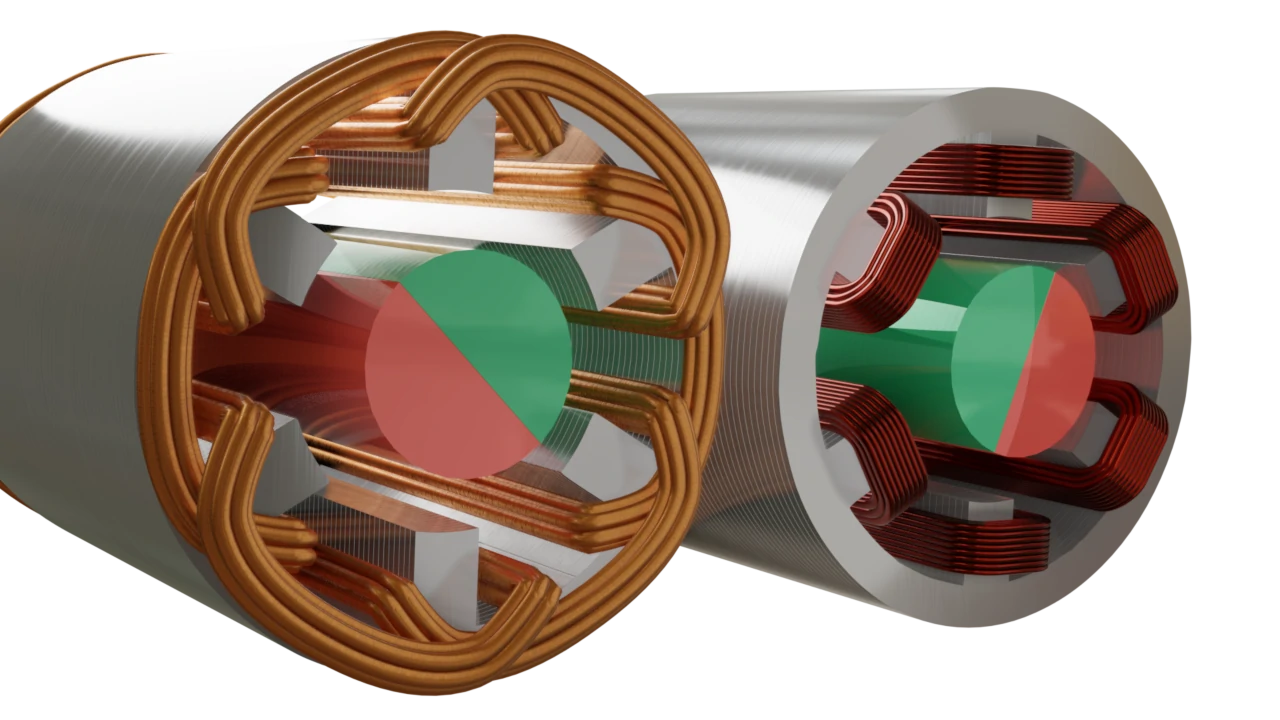Video about Electric Motor Windings
Play Video about electric motor windings video


With a concentrated winding, the stator is always wound exactly over one tooth. This has significant advantages in the manufacture of the stator. For example, already finished windings can simply be pushed onto the stator. However, the design of the stator’s teeth must be designed for this. A major advantage of a concentrated winding is the very small winding head at the top and bottom of the motor. In a distributed winding, this winding head is larger because of the overlap of the windings. Due to the smaller winding head of concentrated windings, the ohmic losses in the lower speed range, are lower all for a distributed winding. When using a classical design of an electric motor with a concentrated development, the back EMF is trapezoidal. As a result, high torque can be generated with this type of winding, especially in the lower range. However, this does not mean that it also results in high efficiency. This is because the main disadvantage of a concentrated winding is the harmonics that are generated, which can lead to high losses, especially at high speeds. These losses can occur in the windings in the laminations as well as in permanent magnets. Concentrated windings are primarily used for motors that are short and have a large diameter. An example of this is wheel hub drives for electric bicycles without gears. Concentrated windings are also used for drives that require high dynamics and efficiency is not so critical. Another disadvantage of concentrated windings is a not insignificant torque ripple. This can be compensated, for example, by moving the magnets on the rotor relative to each other or by shaping the magnets accordingly.
With a distributed winding, at least two teeth of the stator are always wound, as in this example on the picture. How many teeth are wound over is called coil pitch or step size and of course you can also wind over 3, 4, 5 or more teeth. In a distributed winding, the windings overlap at the top and bottom of the electric motor, this area of the motor is also called the winding head. Because of the overlap, the winding head is larger in a distributed winding than in a concentrated winding. For very short electric motors, therefore, a concentrated winding is usually used rather than a distributed winding. This allows the ohmic losses from the winding head to be reduced. For longer electric motors, the influence of the losses from the winding head is not so great in relation to the total losses. A very important advantage of a distributed winding for an electric motor is that the resulting back EMF has a smooth mostly sinusoidal characteristic. This means that the proportion of harmonics is very low and so are the losses in the laminations of the stator and the windings. Distributed windings are used wherever high efficiency is required, such as in electric vehicles. Another advantage of distributed windings is a high synchronism, which means that the torque ripple and therefore also the noise of the motor are very low. For this reason, electric motors with distributed windings are mainly used for rotary spindles of machine tools, otherwise the torque oscillations would have a negative effect on the quality of the workpiece being machined.

In a concentrated winding, one tooth of the stator carries exactly one winding. The different colors stand for the three phases U, V and W. The two windings of one phase are connected to each other and the three phases can then be connected in a star or a delta. In a distributed winding, at least two teeth are wound, as in this example. Over how many teeth is wound is called coil span and of course you can wind over 3, 4, 5 or more teeth. The coil span depends on the number of teeth of the stator and the number of pole pairs of the rotor.

What is the technical difference between a distributed winding and a concentrated winding. For this we will look at the voltage of the back EMF. This is the voltage that can be measured at the terminals of an electric motor with permanent magnets when the motor is rotated fast enough by hand or with a load machine.

In the diagram you can see that the voltage of the electric motor with a distributed winding is nicely sine shaped. On the other hand, the back EMF of the concentrated winding is rather in the shape of a trapezoid. What does this mean for the performance of the motor? With a motor with a concentrated winding you can generate more torque due to the trapezoidal back EMF. However, the losses in the copper and laminations are greater because there are more and higher harmonics. With a distributed winding, you can achieve a higher efficiency due to the sinusoidal back-EMF and this is particularly important for electric vehicles. However, it does not directly mean that if an electric motor has a sine-shaped back EMF, that this motor has a high efficiency. And even with concentrated windings, a sine-wave characteristic of the back EMF can be achieved by adapting the rotor design.